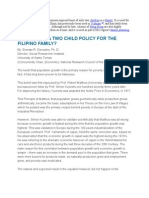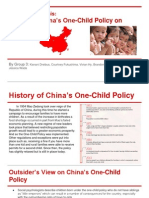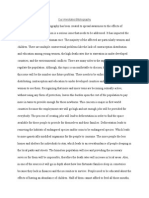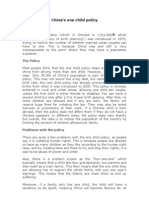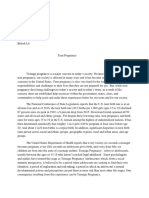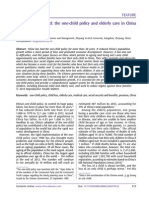One Child 1 1
One Child 1 1
Uploaded by
api-314108012Copyright:
Available Formats
One Child 1 1
One Child 1 1
Uploaded by
api-314108012Original Title
Copyright
Available Formats
Share this document
Did you find this document useful?
Is this content inappropriate?
Copyright:
Available Formats
One Child 1 1
One Child 1 1
Uploaded by
api-314108012Copyright:
Available Formats
The one child per family policy in China influences society
These days more and more Chinese study abroad.
When they
introduce themselves, they always say that they are the only one child in
their family. Its hard to believe it for the foreigners who normally have
at least one sibling. Actually, the one child policy has been one of the
largest and most dramatic population-control campaigns in the world,
receiving both praise and sharp evaluation over the past quarter of a
century. Several unintended consequences of the one child policy have
had an impact on the Chinese society: the unbalanced sex ratios, the high
divorce rate and the acceleration of population aging.
One effect is the one child policy aggravates the unbalanced sex
ratios. Chinese parents traditionally favor boys over girls because they
consider boy a valuable resource for the reason that boys could earn
money for the family and take care of parents in their old age. So when
Chinese parents were allowed to have only one child by the law, they
wish to have a boy instead of a girl. At that time, it was prevalent that
doctors were told to end a pregnancy when the fetus showed signs of
being female. The consequence is that now the China is experiencing the
shortage of girls. The gender ratio at birth is still dangerously high, with
115.88 boys born to every 100 girls in 2014. the official Xinhua news
agency reported. By 2020, the National State Population and Family
Planning Commission projects that in China, males of marrying age will
outnumber females by at least 30 million. (Powell.B)
Another problem is the rising divorce rate.
Strengthened by
Confucianism ideology and administrative measures, the Chinese
institution of marriage has had a stable structure, evidenced by very low
divorce rates. Before 1979 Chinas divorce rates were below 5 divorces
per 100 marriages. Since 1980s, Chinas divorce rates increased from 5%
in 1979 to 13.7% in 2001 (MCA2013). The one child policy has had
some influence on divorce rates in combination with other social changes.
By having only one child this released young couples from additional
child bearing and rearing burdens, and allowed them to devote more time
and energy pursuing their careers and avocations.
Consequently, the
bonds of marriage are loosening in urban areas. When there is a conflict
of interest between wives and husbands, divorce becomes an option.
Finally, the one child policy leads to the acceleration of population
aging. The increased aging of Chinas population is a product of the
implementation of one child policy. A young married couple has to take
care of four parents without help from siblings. When the adult child has
health or aging problems of his or her own, services and support from the
larger society will be required.
The one child policy has been replaced last year though the impacts
on the society will last for decades. Current advantages to small families
are even more built into other developing social and economic changes
and are supportive in the future of small families(Settles.B). The future
of Chinas families will need to include more formal supports for broad
based education, health, old age care, and continued emphasis on the
opening of opportunities in rural as well as urban situations.
References:
1. SETTLES,B. THE ONE CHILD POLICY AND ITS IMPACT ON CHINESE
FAMILIES, DELAWARE UNIVERSITY, 2008 PRINT.
2.P O W E L L , B . G E N D E R I M B A L A N C E : H O W C H I N A ' S O N E - C H I L D
L AW B A C K F I R E D O N M E N . Newsweek.com 2015 .Web. 22 May 2016.
3. POWELL, T. M. THE NEGATIVE IMPACT OF THE ONE CHILD POLICY ON
THE CHINESE SOCIETY . G eorgetown universtity, 2010.Print.
4. Ministry of Civil Affairs of the Peoples Republic of China. Mca.gov.cn 2014.Web.
26 May 2016.
5. XINHUA CHINA FACES GENDER IMBALANCE . News.cn 2015.Web.22 May
2016
You might also like
- ENG Wirt Greg Over The Garden Wall @bastetart v.1.1 O4dkuaDocument75 pagesENG Wirt Greg Over The Garden Wall @bastetart v.1.1 O4dkuacaraleighjaneNo ratings yet
- UploadDocument35 pagesUploadrahul100% (1)
- ESLDocument180 pagesESLJorge Diego PandoNo ratings yet
- Case Study AnalysisDocument9 pagesCase Study AnalysisSwaraj Sidhu100% (1)
- Chinas One Child PolicyDocument5 pagesChinas One Child PolicyktcookieNo ratings yet
- Chinas One Child Policy Thesis StatementDocument7 pagesChinas One Child Policy Thesis Statementlisafieldswashington100% (2)
- Bowman - U2A2Document7 pagesBowman - U2A2bowmansophia576No ratings yet
- Marl KKKKKKKKKKKKKDocument6 pagesMarl KKKKKKKKKKKKKlilice_18No ratings yet
- The One Child PolicyDocument6 pagesThe One Child PolicyKaira SyNo ratings yet
- By Feng Wang and Cai Yong: China's One Child Policy at 30Document2 pagesBy Feng Wang and Cai Yong: China's One Child Policy at 30api-187117805No ratings yet
- Why Impose A Two Child Policy For The Filipino Family?Document10 pagesWhy Impose A Two Child Policy For The Filipino Family?Lennom EspirituNo ratings yet
- One Child Policy ThesisDocument5 pagesOne Child Policy Thesisafknwride100% (2)
- One Child Policy in ChinaDocument7 pagesOne Child Policy in Chinamercy peterNo ratings yet
- Illegal Children Will Be Confiscated: Jul 21st 2011Document1 pageIllegal Children Will Be Confiscated: Jul 21st 2011Randy J Blanco100% (1)
- China's: Recent Effects of The One Child LawDocument4 pagesChina's: Recent Effects of The One Child LawMarvin RinonNo ratings yet
- Thesis For Chinas One Child PolicyDocument4 pagesThesis For Chinas One Child PolicyHelpMeWriteAnEssayPortSaintLucie100% (2)
- Geo ReportDocument6 pagesGeo ReportSeyedNo ratings yet
- OneChildPolicy YXetal.Document6 pagesOneChildPolicy YXetal.Jose Antonio Castro SanchezNo ratings yet
- Shirley Ren One-Child Policy Annotated BibliographyDocument11 pagesShirley Ren One-Child Policy Annotated Bibliographyapi-272769797No ratings yet
- DT 83 China's One Child Policy: Not Yet in The Dustbin of HistoryDocument4 pagesDT 83 China's One Child Policy: Not Yet in The Dustbin of HistoryPopulation & Development Program (PopDev)100% (1)
- Project 2 - Group 3 - Kanani Dreibus Courtney Fukushima Vivian Hy Brandon Lee Ilene Tam and Jessica WadaDocument13 pagesProject 2 - Group 3 - Kanani Dreibus Courtney Fukushima Vivian Hy Brandon Lee Ilene Tam and Jessica Wadaapi-259672497No ratings yet
- Kgrover,+2427 8034 1 CEDocument13 pagesKgrover,+2427 8034 1 CEquintongarrett121No ratings yet
- China's One Child PolicyDocument8 pagesChina's One Child PolicyRàbeyà BoshrýNo ratings yet
- Child Abuse in ChinaDocument2 pagesChild Abuse in ChinaabuumaiyoNo ratings yet
- English Ib 3-2Document2 pagesEnglish Ib 3-2api-308826242No ratings yet
- China's One Child PolicyDocument2 pagesChina's One Child Policyada budhirajaNo ratings yet
- One Child PolicyDocument5 pagesOne Child Policynaisha.bhanNo ratings yet
- One Child PolicyDocument15 pagesOne Child Policyajaykumar0011No ratings yet
- Engexam - info-IELTS Reading Practice Test 15 PrintableDocument6 pagesEngexam - info-IELTS Reading Practice Test 15 PrintableDadexNo ratings yet
- China's One-Child PolicyDocument7 pagesChina's One-Child PolicynietoperkiNo ratings yet
- Our Annotated BibliographyDocument26 pagesOur Annotated Bibliographyapi-264042287No ratings yet
- China One Child PolicyDocument6 pagesChina One Child PolicyMEENAL GUPTANo ratings yet
- China and India - Case Study PDFDocument2 pagesChina and India - Case Study PDFThird MontefalcoNo ratings yet
- One Child and ConfucianismDocument3 pagesOne Child and Confucianismburns8459No ratings yet
- Baby BoomDocument2 pagesBaby Boomalc3254No ratings yet
- China's Lost Little Emperors... How The One-Child Policy' Will Haunt The Country For DecadesDocument4 pagesChina's Lost Little Emperors... How The One-Child Policy' Will Haunt The Country For DecadesMinh ThưNo ratings yet
- Chinas One Child PolicyDocument4 pagesChinas One Child PolicyMzzbabygirl GordonNo ratings yet
- Research PaperDocument19 pagesResearch PaperAnuj KhannaNo ratings yet
- Research PaperDocument23 pagesResearch PaperAnuj Khanna100% (1)
- China's One Child PolicyDocument15 pagesChina's One Child PolicyPaola Robles100% (1)
- 1AC FemicideDocument59 pages1AC FemicideWood OreNo ratings yet
- One Child Policy Literature ReviewDocument8 pagesOne Child Policy Literature Reviewc5eyjfnt100% (1)
- Cause and Effect of China One-Child PolicyDocument2 pagesCause and Effect of China One-Child PolicyShuqi LiuNo ratings yet
- Sexism An Emerging Reality?: Review of Topic: Missing Girls in Vietnam: Is High TechDocument8 pagesSexism An Emerging Reality?: Review of Topic: Missing Girls in Vietnam: Is High TechPark Young MiNo ratings yet
- Current Events ArticleDocument2 pagesCurrent Events Articleapi-297277790No ratings yet
- 82 Passage 1 - Q1-13Document6 pages82 Passage 1 - Q1-13philong6673No ratings yet
- Research PaperDocument19 pagesResearch PapermasfiqNo ratings yet
- Kayla Green - Research Paper Draft 1 - Pages 1-3 Include Your Works Cited PageDocument7 pagesKayla Green - Research Paper Draft 1 - Pages 1-3 Include Your Works Cited Pageapi-458133015No ratings yet
- Losing An Only Child: The One-Child Policy and Elderly Care in ChinaDocument12 pagesLosing An Only Child: The One-Child Policy and Elderly Care in Chinajilbo604No ratings yet
- China Anti Natalist Case StudyDocument3 pagesChina Anti Natalist Case Studyapi-294752216No ratings yet
- China 1Document15 pagesChina 1ariana akbarNo ratings yet
- China Launches Match Making Campaign As Marriage and Birth Rates Drop - The Economic TimesDocument2 pagesChina Launches Match Making Campaign As Marriage and Birth Rates Drop - The Economic TimesAnupNo ratings yet
- Activity 1:: The Contemporary WorldDocument2 pagesActivity 1:: The Contemporary WorldDexie James Ventenilla DizonNo ratings yet
- Activity 1Document2 pagesActivity 1Kristian Karl Bautista Kiw-isNo ratings yet
- Influential Factors of Entering A Nursing Home and Family Intergenerational Relationships in ShanghaiDocument19 pagesInfluential Factors of Entering A Nursing Home and Family Intergenerational Relationships in ShanghaiDươngNo ratings yet
- Our Youth's Risky Sexual Behavior Is From Lack of Knowledge and Understanding of Sex. So Sex Education Should Be Given To Young. Agree or DisagreeDocument6 pagesOur Youth's Risky Sexual Behavior Is From Lack of Knowledge and Understanding of Sex. So Sex Education Should Be Given To Young. Agree or DisagreeYmmarie Autor RamosNo ratings yet
- Teenage PregnancyDocument27 pagesTeenage PregnancyMaricel Ceyh GonzalesNo ratings yet
- International Organizations and Their Role in Addressing Gender - Based Injustice in Domestic AffairsDocument14 pagesInternational Organizations and Their Role in Addressing Gender - Based Injustice in Domestic Affairsmitalirakhecha19.solNo ratings yet
- Position PaperDocument3 pagesPosition Paperv.rosos.134465.tcNo ratings yet
- Policy Brief: The Implications of Abandonment Issues Among Left-Behind ChildrenDocument4 pagesPolicy Brief: The Implications of Abandonment Issues Among Left-Behind ChildrenKelvin NziokiNo ratings yet
- One Child Policy Essay ThesisDocument8 pagesOne Child Policy Essay Thesisdpk9wjs9100% (1)
- Latihan GerundDocument3 pagesLatihan GerundJenny ChristantiNo ratings yet
- Module IIDocument6 pagesModule II22r11a04g9No ratings yet
- Insurance Law Unit 2Document11 pagesInsurance Law Unit 2Priyanka DhamaNo ratings yet
- TECDEN Mwanza Strategic Plan 2014-2018Document47 pagesTECDEN Mwanza Strategic Plan 2014-2018Lucas AlphiusNo ratings yet
- Activity No.7 Gram StainDocument3 pagesActivity No.7 Gram StainfarahjundanNo ratings yet
- New Product DevelopmentDocument3 pagesNew Product Developmentविशाल गुप्ताNo ratings yet
- StatCon Second Set (Printed)Document131 pagesStatCon Second Set (Printed)AldrinmarkquintanaNo ratings yet
- Ccim Fee Refund FormDocument1 pageCcim Fee Refund FormMohammad ShafiqueNo ratings yet
- tyranids 7Document1 pagetyranids 7fabriziobackup.07.09.2024No ratings yet
- Labor Case DigestDocument2 pagesLabor Case DigestKR ReborosoNo ratings yet
- SawatdeeDocument3 pagesSawatdeeHarith Mage Main50% (2)
- Fuso NZ Canter 616 City Cab 170505 MR 0Document4 pagesFuso NZ Canter 616 City Cab 170505 MR 0hamzetoh143No ratings yet
- Company Meaning and FeaturesDocument9 pagesCompany Meaning and FeaturesRahulNo ratings yet
- Lac Session MinutesDocument4 pagesLac Session MinutesEugen Estrella Chavez-Solis BalasabasNo ratings yet
- البحث ص245 العلمي مسعود حسين 2018Document383 pagesالبحث ص245 العلمي مسعود حسين 2018bassel123.nnNo ratings yet
- Cherthala Pooram: Sree Karthyayani Devi TempleDocument3 pagesCherthala Pooram: Sree Karthyayani Devi TempleHarisankar Karthika HariharanNo ratings yet
- Gsis Family Bank - Thrift Bank vs. Bpi Family Bank, GR No. 175278, September 23, 2015Document14 pagesGsis Family Bank - Thrift Bank vs. Bpi Family Bank, GR No. 175278, September 23, 2015Jerry SerapionNo ratings yet
- Laws Governing Heavenly KingdomsDocument2 pagesLaws Governing Heavenly Kingdomsdavo.benjaminNo ratings yet
- Indigenous Knowledge in Gabut Norte, Badoc, Ilocos NorteDocument13 pagesIndigenous Knowledge in Gabut Norte, Badoc, Ilocos NorteMarese PrietoNo ratings yet
- Mock Exam: Grade 3 Science, 1st Quarter Long TestDocument3 pagesMock Exam: Grade 3 Science, 1st Quarter Long TestJoyceNo ratings yet
- Tingkat Pendidikan Ibu Dan Pola Asuh Gizi Hubungannya Dengan Kejadian Stunting Pada Balitausia 24-59 BulanDocument9 pagesTingkat Pendidikan Ibu Dan Pola Asuh Gizi Hubungannya Dengan Kejadian Stunting Pada Balitausia 24-59 BulanMaulida FajriyahNo ratings yet
- لملومDocument12 pagesلملومomarwafy271No ratings yet
- Types of SeminarsDocument2 pagesTypes of SeminarsLois Malit100% (6)
- C TADM55a 75. TelegramDocument20 pagesC TADM55a 75. TelegramSAP E-learnNo ratings yet
- MS - Unit - Iv-1Document25 pagesMS - Unit - Iv-1VELU KNo ratings yet
- 英语语法基础练习题Document231 pages英语语法基础练习题RachelNo ratings yet
- GPS Velocities and The Construction of The Eastern Cordillera of The Eastern Cordillera of The Colombian AndesDocument10 pagesGPS Velocities and The Construction of The Eastern Cordillera of The Eastern Cordillera of The Colombian Andeslorenatb674No ratings yet










